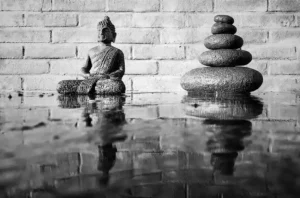Table of Contents
ToggleBuddhism is a faith founded by way of Siddhartha Gautama—also called “the Buddha”—more than 2,500 years ago in India. With a predicted 500 million to 1000000000 fans, scholars recollect Buddhism as one of the primary international religions. As a non-theistic religion without a god or deity to worship, a few scholars describe Buddhism as a philosophy or an ethical code instead of an organized faith.
Many of the beliefs and practices of Buddhism revolve around the concept of suffering and its causes. Buddhism has historically been maximum distinguished in East and Southeast Asia, however, its have an impact on growing in the course of the West. Many Buddhist ideas and philosophies overlap with the ones of different faiths.
The Path to Illumination: Enlightenment in Buddhism
What is Enlightenment?
Enlightenment, also known as Nirvana, signifies a kingdom of complete awakening. It’s characterized by the eradication of dreams like greed, hatred, and fantasy, main to lasting peace and freedom from struggling. Imagine a mind unfastened from the regular churn of terrible emotions and anxieties, replaced by a profound know-how of reality and a deep feeling of serenity.
Different Stages of Enlightenment
In Mahayana Buddhism, scholars developed models to clarify the specific nature and phase of bodhicitta (“insight” or “consciousness of awakening”): There are two main stages in the development of bodhicitta:
1) The nature of Bodhichitta which is prone to loss.
2) The perennial quality of the Bodhisattva gives direct light without loss.
Furthermore, as Shantideva suggested, there are two types of bodhichitta:
1) desire or desire alone manifests Bodhichitta.
2) Active bodhicitta, which involves actual practice of the method according to one’s mind.
Multiple Paths to Enlightenment
Buddhism recognizes that there are different paths to enlightenment. These traditions offer a variety of methods to suit the needs and desires of different individuals, making Buddhism a flexible and diverse spiritual path.
Theravada Buddhism emphasizes the Pali path and the eighth path. Practitioners aim to attain personal liberation (nirvana) through meditation, wisdom, and ethical living, and to attain arhat status.Mahayana Buddhism emphasizes the path of the Bodhisattva, who sacrifices his freedom to save all beings.
In Pure Land Buddhism, devotees reverently invoke the name of Amitabha Buddha, longing for his rebirth in the Pure Land, where greater enlightenment is possible. Nichiren Buddhism focuses on chanting the Lotus Sutra and the mantra “Namu Myoho Renge Kyo” to achieve enlightenment.
The Journey Towards Enlightenment
This nation isn’t completed overnight. The route to enlightenment is printed within the Noble Eightfold Path, a framework encompassing three pillars: ethical behavior (Right Action, Right Speech, and so forth.), mental development (Right Mindfulness, Right Concentration), and expertise (Right View, Right Intention).
The Noble Eightfold Path is a sensible manual, no longer an inflexible set of guidelines. It emphasizes the importance of cultivating moral conduct, growing focused and mindful thoughts, and nurturing wisdom to look at the sector without a doubt and apprehend its authentic nature.
Meditation and Mindfulness: Cultivating Inner Peace
- Types of Meditation: Meditation, a core Buddhist practice, cultivates cognizance and cognizance. Various strategies exist, catering to extraordinary gaining knowledge of styles and choices. Some recognition focuses on the breath, whilst others involve mindfulness meditation, where normal activities emerge as opportunities for gift-moment focus.
- Importance of Mindfulness for Enlightenment: Mindfulness, nurtured via meditation, permits one to have a look at thoughts and feelings without judgment. This self-cognizance is crucial for information and in the end, transcending the cycle of suffering. By staring at our thoughts and feelings without getting stuck up in them, we can start to see them for what they may be – fleeting mental phenomena – and detach from their grip.
The Cornerstone of Practice: Unveiling Buddhist Ethics
What is Buddhist Ethics?
Buddhist ethics, called Sila, are a fixed of moral standards that manual a mindful and compassionate lifestyle. They offer a framework for navigating everyday interactions and fostering a greater harmonious life.
The Five Precepts: A Foundation for Ethical Living
These core principles are the Five Precepts:
- Avoid harming dwelling beings: This principle extends past physical damage and encourages respect for all existing paperwork.
- Taking what isn’t always rightfully yours: This precept promotes honesty and discourages stealing, exploitation, or taking the benefit of others.
- Engaging in misconduct: This principle emphasizes sexual obligation and constancy within committed relationships.
- False Speech: This principle discourages lying, gossiping, and the use of harsh language which can damage others.
- Intoxicants: This precept encourages a clear and aware kingdom of being, discouraging using materials that cloud judgment and avert self-awareness.
Compassion and Kindness: The Essence of Buddhist Ethics
Buddhist ethics go beyond simply adhering to rules. They are rooted in the middle values of compassion and kindness.
- Understanding Compassion: Compassion, Karuna in Pali, is the empathetic understanding of some other’s suffering coupled with an actual preference to alleviate it. It’s no longer simply feeling sorry for a person; it is an active want to assist them in discovering peace and well-being.
- Practicing Kindness and its Impact: Kindness, Metta in Pali, entails actively fostering nicely-being for all beings. It begins with cultivating loving-kindness in the direction of oneself and extends outwards to embody cherished ones, strangers, and even those we discover difficult. Kindness is not about blind positivity; it’s about recognizing the interconnectedness of all beings and wishing for their happiness.
By cultivating compassion and kindness, we now not handiest gain others but also create an extra non-violent and harmonious surrounding for ourselves and each person around us.
In the massive international of Buddhism, each enlightenment and ethics holds well-sized weight. They are not competing dreams, but instead complementary elements of a novel course. By cultivating moral behavior and a compassionate coronary heart, we pave the way for the information and liberation that lie in the coronary heart of enlightenment.
Ultimately, the principle goal of Buddhism is an issue of private interpretation. However, the deep connection between residing ethically and reaching enlightenment is plain. Consider exploring more Buddhist teachings from hiddenmantra in addition and embarking on your very own journey of self-discovery and compassionate residing.








